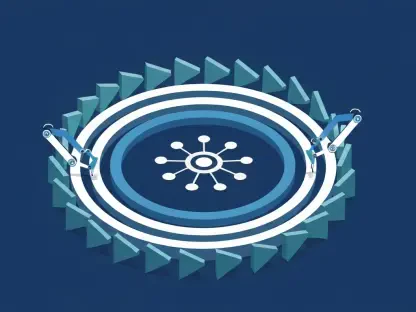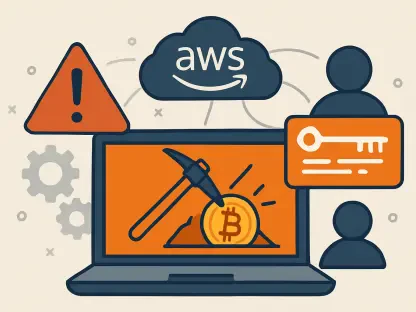In an era where cyber threats evolve at breakneck speed, staying updated on the latest advancements in endpoint security and network monitoring is not just beneficial—it’s essential for organizations aiming to safeguard their digital landscapes against increasingly sophisticated attacks. The week of October 10th brought a flurry of significant updates from industry leaders such as Netskope, Exabeam, Ridge Security, Ivanti, Mindgard, and Nokia. These developments span cutting-edge technological innovations, pivotal leadership changes, and critical insights into the ever-shifting threat environment. From AI-driven security enhancements to sobering reports on attack speeds, the announcements paint a vivid picture of a sector striving to outpace sophisticated cybercriminals. This roundup delves into the core of these updates, exploring how they reflect broader industry trends and what they mean for the future of cybersecurity. The focus remains clear: resilience, adaptability, and proactive defense are paramount in today’s digital battleground.
Technological Innovations in Endpoint Security
AI and Automation Take Center Stage
The integration of artificial intelligence (AI) into cybersecurity tools is reshaping how threats are detected and mitigated, and this week’s updates highlight that transformation in striking ways. Netskope has rolled out significant enhancements to its Universal Zero Trust Network Access (UZTNA) solution, incorporating AI-powered policy optimization through a feature known as Copilot. This tool aims to streamline security configurations with intelligent, context-aware adjustments. Similarly, Ridge Security introduced RidgeGen, an Agentic AI framework embedded in its RidgeBot platform. RidgeGen leverages large language models and domain-specific expertise to enable autonomous threat validation, pushing beyond traditional automation. These advancements signify a pivotal shift toward systems that don’t just react to threats but anticipate them, offering a proactive layer of defense that is becoming indispensable in modern security architectures.
Beyond the initial unveiling of these tools, the implications of AI in endpoint security are profound and far-reaching for enterprises navigating complex digital environments. Netskope’s updates also include embedded threat and data protection within its UZTNA solution, ensuring a holistic approach to safeguarding access points. Meanwhile, Ridge Security’s focus on accuracy in exploit testing across IT, OT, and AI infrastructures demonstrates how AI can refine the precision of security validations. This dual emphasis on intelligence and autonomy reflects an industry consensus that manual processes are no longer sufficient against today’s rapid-fire cyber risks. As these technologies mature, they promise to reduce human error and response times, allowing security teams to focus on strategic oversight rather than repetitive tasks, ultimately fortifying organizational defenses against increasingly cunning attacks.
Scalability and Resilience in Focus
Scalability remains a cornerstone of effective endpoint security, and recent updates from Ivanti underscore this priority with the release of version 25.X of its Connect Secure platform. Built on a modernized Oracle Linux operating system, this update introduces enhanced platform hardening and gateway improvements designed to minimize vulnerabilities and shrink attack surfaces. Whether deployed in cloud, virtual, or hardware environments, the platform’s enterprise-grade performance caters to the diverse needs of modern IT infrastructures. This focus on robust, adaptable systems ensures that organizations can maintain operational continuity even as cyber threats grow in complexity, highlighting Ivanti’s commitment to resilience in a landscape where flexibility is as critical as strength.
Complementing this trend, Netskope has extended its UZTNA capabilities to include access to private applications in branch networks through the innovative 5G Netskope One Gateway. This development addresses the growing demand for seamless, secure connectivity across distributed environments, ensuring that remote and branch locations are not weak links in the security chain. By prioritizing scalability alongside cutting-edge access solutions, Netskope reinforces the notion that endpoint security must evolve to cover every corner of an organization’s digital footprint. These updates from both Ivanti and Netskope illustrate a broader industry push to build systems that not only withstand current threats but also adapt to future challenges, providing a foundation for long-term cybersecurity stability in an unpredictable threat landscape.
Leadership and Strategic Growth
New Faces at the Helm
Leadership transitions often signal a turning point for companies, and this week’s news from Exabeam and Mindgard reflects strategic pivots aimed at sustaining growth in the competitive cybersecurity market. Exabeam announced the appointment of Pete Harteveld as its new Chief Executive Officer, succeeding Chris O’Malley, who stepped down after a notable tenure. Harteveld has expressed a vision to build on the company’s strong market position, focusing on innovation and customer value. This change underscores Exabeam’s intent to maintain its trajectory as a leader in security operations through fresh perspectives and renewed strategic direction, ensuring it remains agile in addressing client needs amidst a rapidly evolving industry.
In parallel, Mindgard has welcomed James Brear as its new CEO, bringing over 15 years of cybersecurity leadership experience to the role. This appointment aligns with Mindgard’s broader goals of strengthening its position in the AI security space, where expertise at the executive level can drive impactful decision-making. Unlike mere personnel changes, these transitions at both companies signify a deeper commitment to harnessing seasoned guidance to navigate market challenges. The emphasis on experienced leadership highlights an understanding that technological advancements must be paired with visionary direction to achieve lasting success, positioning both Exabeam and Mindgard to tackle future obstacles with confidence and clarity.
Geographic and Expertise Expansion
Mindgard’s strategic growth extends beyond leadership, as the company has established a new U.S. headquarters in Boston, marking a significant step toward expanding its global presence. This move is not just about physical location but about tapping into the rich talent pool and market opportunities in the U.S., particularly in the realm of AI security solutions. By setting up a base in a key innovation hub, Mindgard aims to foster closer collaboration with American enterprises and accelerate its growth trajectory. This geographic expansion reflects a calculated effort to position the company at the forefront of a market increasingly focused on AI-driven defenses, ensuring it can respond swiftly to regional demands and trends.
Adding to this momentum, Mindgard has brought on Rich Smith, a seasoned offensive security researcher, to bolster its technical expertise. This addition complements the company’s leadership overhaul and geographic outreach, emphasizing the importance of specialized knowledge in refining security offerings. Such hires are pivotal in an industry where staying ahead of adversaries requires not just tools but deep, actionable insights into threat methodologies. Together, these steps illustrate a holistic approach to growth, where physical expansion and intellectual capital work hand in hand to enhance Mindgard’s competitive edge, offering a model for how cybersecurity firms can scale effectively in a globalized, threat-laden environment.
Threat Intelligence and Industry Challenges
Rapid Threats and Persistent Vulnerabilities
The speed at which cyber threats unfold continues to challenge even the most prepared organizations, as evidenced by Nokia’s latest Threat Intelligence Report released this week. A striking finding reveals that 78% of Distributed Denial of Service (DDoS) attacks are now resolved within five minutes, a significant increase from previous benchmarks. This acceleration in attack resolution underscores the growing sophistication of threat actors and the corresponding need for equally rapid defense mechanisms. However, the report also flags a persistent issue: 76% of vulnerabilities stem from unpatched systems, a glaring weak spot that leaves many organizations exposed. These insights serve as a critical reminder that speed and diligence in system maintenance are non-negotiable in today’s cybersecurity landscape.
Delving deeper into these findings, the dual challenge of rapid attacks and systemic vulnerabilities demands a multifaceted response from security professionals. The brevity of DDoS attacks, while seemingly positive due to quick resolution, often means that damage can be inflicted before defenses fully activate, necessitating preemptive strategies. Meanwhile, the prevalence of unpatched systems points to gaps in basic cybersecurity hygiene that no amount of advanced technology can fully compensate for. Nokia’s report, drawn from extensive data across its NetGuard and Deepfield portfolios, emphasizes that organizations must prioritize timely updates and robust monitoring to close these gaps. Addressing these intertwined issues is essential for building a resilient security posture capable of withstanding the relentless pace and ingenuity of modern cyber threats.
Staying Proactive in a Dynamic Threat Landscape
The urgency to stay ahead of cyber threats is a unifying theme across this week’s updates, with Nokia’s insights serving as a catalyst for broader industry reflection. The rapid evolution of attack methods, coupled with the persistence of foundational weaknesses like unpatched systems, paints a picture of a sector under constant pressure to innovate. Beyond mere reaction, the focus must shift to proactive measures—anticipating threats through continuous monitoring and leveraging advanced tools for real-time threat detection. This approach is vital for organizations aiming to protect critical assets in an environment where attackers exploit even the smallest window of opportunity, making foresight a key component of effective defense strategies.
Complementing this need for proactivity, the technological strides made by companies like Netskope and Ridge Security offer a glimpse into how innovation can counterbalance emerging risks. AI-driven solutions and autonomous validation frameworks provide the agility required to address threats as they arise, reducing reliance on slower, manual processes. However, technology alone isn’t enough; Nokia’s findings remind the industry that human oversight in maintaining systems and applying updates remains critical. As cyber threats grow in complexity, a balanced strategy that combines cutting-edge tools with disciplined operational practices will be the linchpin for enduring security, ensuring that organizations are not just responding to dangers but actively preventing them.
Reflecting on a Week of Critical Insights
Looking back on the week of October 10th, the endpoint security and network monitoring sector demonstrated both its innovative spirit and its acute awareness of persistent challenges through a series of impactful announcements. Companies like Netskope and Ridge Security pushed the envelope with AI-driven tools, while Ivanti reinforced the importance of scalable, resilient systems. Leadership shifts at Exabeam and Mindgard signaled strategic intent to navigate a competitive market, and Nokia’s report laid bare the stark realities of rapid attacks and unpatched vulnerabilities. For organizations moving forward, the path is clear: invest in advanced technologies that anticipate threats, prioritize system updates to eliminate weak points, and ensure leadership is equipped to steer through turbulent times. Embracing these actionable steps will be crucial to fortify defenses against an ever-shifting cyber landscape, setting the stage for sustained security in the months ahead.









